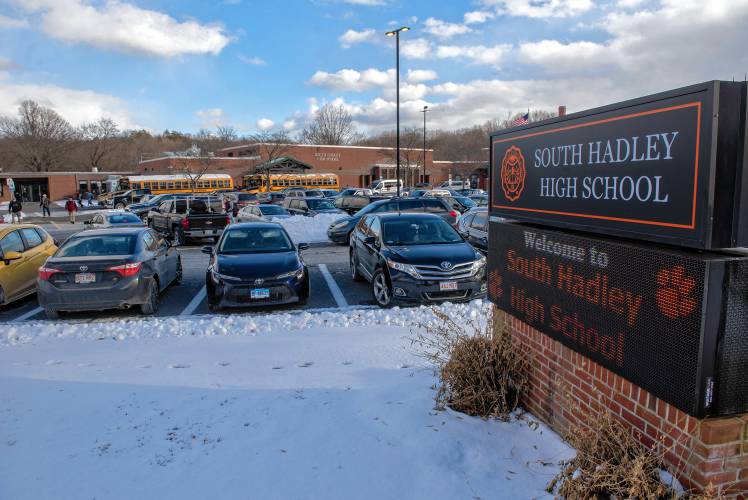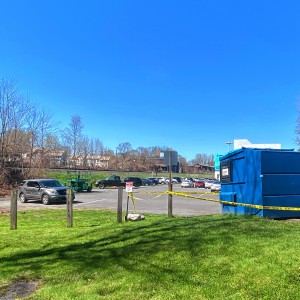South Hadley schools expect layoffs to approach 30 positions

South Hadley High School GAZETTE FILE PHOTO
| Published: 03-22-2024 5:11 PM |
SOUTH HADLEY— The school district anticipates cutting at least 27 positions — the most any school system in Hampshire County has announced so far this spring — next fiscal year as officials grapple with a $1.2 million budget deficit being driven by higher transportation and salary costs that far outpace state aid coming in.
At a School Committee budget presentation Wednesday, district officials outlined a $25.5 million budget for fiscal year 2025 — and the various budget factors that are expected to result in the loss of four teaching and 23 paraeducator positions.
The School Board voted to recommend the budget, which will be included in the town’s overall budget that goes to Town Meeting this spring, despite residents expressing concern over losing paraeducators in kindergarten classes and in special education, leaving the remaining staff overburdened.
“In special education, the services we provide for students need to be based on our students’ needs. I feel as though some of the decisions we are making are based on the district’s needs,” said Amy Foley, president of the South Hadley Education Association.
At Wednesday’s meeting, district officials outlined some of the items affect the district’s budget. Among those are continued increases in transportation costs, which are projected to jump by $97,000 next year.
The district also approved cost-of-living and yearly step increases for teachers and staff over the next three years, adding $900,000 to salary allocations in the budget.
Meanwhile, the district is not receiving enough Chapter 70 money — funds awarded from the state to municipalities for education — to keep up with these additional expenses. A drop in enrollment in recent years is also contributing to the town’s receiving less Chapter 70 money. In the current school year, the district had 1,673 students, the lowest its been in five years.
“We’re at a point where again at minimum state aid so basically what the state does is it takes the number of students that they have and multiply it by $30 and that is what your increases for the year,” said Jennifer Voyikm, assistant superintendent for finance and business operations.
Article continues after...
Yesterday's Most Read Articles
 Police report details grisly crime scene in Greenfield
Police report details grisly crime scene in Greenfield
 Super defers Amherst middle school principal pick to successor; one finalist says decision is retaliation for lawsuit
Super defers Amherst middle school principal pick to successor; one finalist says decision is retaliation for lawsuit
 Homeless camp in Northampton ordered to disperse
Homeless camp in Northampton ordered to disperse
 Authorities ID victim in Greenfield slaying
Authorities ID victim in Greenfield slaying
 Haydenville residents resist Greenway trail plan, float alternative design
Haydenville residents resist Greenway trail plan, float alternative design
 Locking up carbon for good: Easthampton inventor’s CO2 removal system turns biomass into biochar
Locking up carbon for good: Easthampton inventor’s CO2 removal system turns biomass into biochar
While the district is looking at layoffs, administrators are also proposing the addition of several positions in next year’s budget, including educational therapy assistants, one assistant principal at the high school, one teacher of the deaf and one certified nursing assistant to address mental and physical health, as well as special educational needs of students with hearing impairments.
“We tried to do a lot of things with school budgets. We want to most importantly, provide the inclusive and innovative educational environment for our students,” interim Superintendent Mark McLaughlin said. “But at the same time, we recognize that we owe a true and responsible budget to those who fund us and so we’re hoping and believe that the budget that we have before you reflects the marriage of those two imperatives.”
McLaughlin said he believes next year’s budget will not impact the way children are educated because the district is in the process of updating educational instruction, including how individualized education progams (IEPs) are implemented for students. McLaughlin did not elaborate on these changes at the hearing.
“We wouldn’t have put this forth if we thought that we couldn’t provide the services to the students that we owe them,” McLauhglin said. “What we’re trying to do is make sure that the toolbox is current, that people are provided with supports to implement it, and then hopefully, there will be a decrease in the need for [paraeducators] because we’ve been able to address it right at the classroom level.”
Residents expressed concern that the projected cuts would diminish the quality of education in both kindergarten and special education.
“I know when my children were 5 years old, I knew what it was like to get them to attend to something for any amount of time,” said Foley, the teacher’s union president. “I couldn’t imagine having to do that alone in a classroom with 20 5-year-olds and not have any support.”
Foley added that paraprofessionals in special education are critical for IEP compliance. These staff members collaborate with parents, teachers and hired service providers to advise and enforce IEPs.
Special Education Parent Advisory Council Chair Tracie Kennedy said special education staff already feel overburdened by the number of special ed students, and removing the paraprofessionals who support these specialists will only exacerbate the issue.
“In meetings with the (special education team leaders), most recently they are saying that their caseloads are too high. With the service providers such as your (occupational therapists), your speech and language pathologist, they’re saying their caseloads are too high. This budget does not reflect anything in regards to supporting those individuals,” she said.
As a parent of three children who receive special education services, Kennedy also expressed concern over additional support for the new teacher of the deaf. Voyik said teacher of the deaf in particular will save money by preventing students with hearing impairments from leaving the district, raising out-of-district tuition and transportation costs. But Kennedy said adding a teacher of the deaf alone without the proper equipment, health services and environmental changes will leave major gaps in educational services for hearing-impaired students.
“The costs associated with the equipment and the changes environmentally and physically to the building are going to be significant impacts and just simply saying that you’re going to bring a teacher of the deaf in to give you advice as to what those changes need to be, it’s not that simple,” she said.
McLaughlin added that the district has looked into costs associated with a audiologist and equipment, but those numbers are not reflected in the budget.
Despite residents questioning the district’s choices, McLaughlin and Voyik stood by the budget, saying these reductions will be paired with major instructional changes. McLaughlin uses the elementary literacy program rolled out last year as an example: By revamping the way reading and literacy is taught at the primary education level, there will be less need for special education paraeducators to help students struggling with literacy.
“While it may seem like, and some of it does have to do with the state that the district is facing with a reduction in Chapter 70 aid, I don’t want the public to think this that was the only reason” (for the cuts,) Voyik said. “There has been an ongoing review throughout the district and a particular piece of it is looking at what is being suggested and what are we providing for students.”
Emilee Klein can be reached at eklein@gazettenet.com.

 Federal probe targets UMass response to anti-Arab incidents
Federal probe targets UMass response to anti-Arab incidents William Strickland, a longtime civil rights activist, scholar and friend of Malcolm X, has died
William Strickland, a longtime civil rights activist, scholar and friend of Malcolm X, has died
